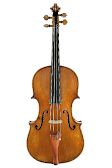Giovanni Battista Ceruti
1756–1817When Carlo Bergonzi died in 1747, Cremona lost the last of the direct successors to Stradivari. The following generations of luthiers could not continue this rich tradition, not least because of the political and economic conditions prevailing in Italy in the late 18th century. The Napoleonic wars and the alternation between French and Habsburg reign impeded cultural life, commercial trade and the supply of raw materials. These restrictions also affected Giovanni Battista Ceruti’s occupational development. Ceruti was born in Sesto Cremonese in 1756 and moved to Cremona in 1786. He first worked as a weaver and only later acquired violinmaking skills from Count Alessandro Maggi, an amateur violinmaker and collector. Apart from Ceruti, only Lorenzo Storioni (1744–1816) worked as a luthier in Cremona during this period. Ceruti took over Storioni’s atelier when the latter had left the city in 1802. Ceruti built the majority of his instruments in the years until 1815. He died in 1817, a victim of an outbreak of typhoid fever. Ceruti’s descendants became luthiers as well: His son Giuseppe (1785–1860) took over the workshop, and his grandson Enrico (born in 1806) was able to continue the tradition until his death in 1883.

